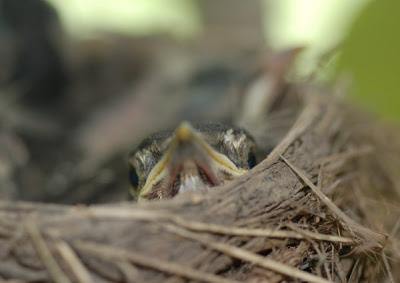
We've been watching a robin's nest in the basswood tree by the woodshed, the same structure that was recently the home of a phoebe family. Like the voracious phoebe nestlings, the four little robins have grown very fast.




There's quite an increase in feathers between the first two and the last two nestling photos, and the last photo shows the mother robin watching the photo session with concern. I hadn't noticed until our recent visit from a Wood Thrush how much alike the birds are built.
Emma Bell Miles, in Our Southern Birds (1919), contrasts the song of the American Robin with the Wood Thrush:
What an active, gladsome, vigorous fellow [the Robin] is, and how clearly and fully he expresses all his feelings in his various notes. No refinement of musical culture, such as graces his kinsmen the Thrushes, belongs to him, no elegance of gentle manners; we might say that the Wood Thrush is a violinist to whose recitals we listen in admiration, and Robin is a fiddler to whose jolly strains we may dance with glee. His notes ring with positive gladness; his every motion is decided and free, his bearing alert and open; his presence dominates the lawn or orchard.
Mrs. Miles wrote this book as she lay dying in a tuberculosis sanitarium for the indigent. She intended it to be used by teachers in southern schools, and hoped that its sale would provide for her young children after her death. I don't think either of these intentions came to pass, but the project must surely have brightened her thoughts.
No comments:
Post a Comment